#One-Pot Synthesis
Explore tagged Tumblr posts
Text
People have long dreamed of developing materials to circumvent the challenges of daily life. Ideally, one could capitalize on a combination of the features of different materials, profiting from their advantages while avoiding the disadvantages. In chemistry, this concept has been applied to hybrid materials, particularly with the combination of organic and inorganic compounds. Organic materials are known for their functional diversity, while inorganic materials offer superior stability. However, the fusion of organic and inorganic substances poses significant challenges due to the differing reaction conditions required for their formation. The research team led by Professor Miriam Unterlass at the University of Konstanz employs a method that balances these contrasting conditions, allowing the reactions to occur simultaneously and synergistically in a single reaction vessel. Chemists have named this method "one-pot synthesis."
Continue Reading.
76 notes
·
View notes
Text
minor update to the twerk-thineself-to-god, the-silence-is-the-answer post:
last week's sesh was the party finally entering the temple of a long dead dragon god. i basically just threw all of the weird esoteric symbolism that i know at them. everything in the temple was colored in alternating bands of black, white, red, black, white, red, with the black sections always having bas relief imagery of various afterlifes, the white images having intaglio relief images of the physical plane, and the red images showing hybridizations of the two.
like, the black section migth have flies buzzing over a field of slaughter, and the white section might show birds flying around a field of ripened grain, but then the red section might show horrific birds with fly eyes, or fly wings, or flies with bird wings and birds. just unsettling stuff like that. with all the fly parts jutting out of the stone, but all the bird parts being carved in.
idea was references to the alchemical processes nigredo, albedo, and rubedo, and the general dialectic processes of thesis, anthesis, synthesis, being applied to life and death. make something that isn't alive, or dead, or undead.
i didn't have a plan for this at the time, i just think it's neat and sets a very unsettling atmosphere.
boss arena was just a giant laboratory. the boss was a divine/arcane type caster that was trying to assemble a dragon shaped flesh golem about of hundreds of scavenged corpses. dragon golem was huge and a different motif i'd thrown in earlier to the campaign were these parasitic red crystals that they'd find growing off some corpses in the wood. sometimes partially harvested. sometimes found in living things that were insanely aggressive. again, no real plan, just creepy shit for its own sake. they'd kill people infested with the crystals and they'd babble about how it had made it too quiet to think. how good it felt to be able to think again, outside that silence.
anyway, i said the crystals were being used as scales for the false-dragon and they were all like AAAAAAAAAAAAAA
cue boss fight. still trying to figure out what to do with the silence thing. one of them gets downed. they're unconscious but they're not dead. cues my idea. i tell the unconscious guy he wakes up in a sort of silent pocket dimension. between life and death. and that there is something there with him. something huge.
so i had run like crazy around the purgatory space, trying to avoid the living-god dreaming-death mystery thing before it eats his soul, while the party fought the priest of that thing and killed it. then they could give him a healing pot. first thing he did after regaining consciousness was start babbling about the the silence and the dead god. they almost killed him again because they thought he was getting possessed or something. might come back to that later. it's a good idea to have in my pocket.
anyway, that's how flying by the seat of my pants is going. next session is loot divvying and heading back to town for R&R. the wizard in the group is super interesting in making golems, and the lab is like. perfectly set up for making flesh golems. so mayhaps i will try to lead him down the path of evil mayhaps. i think wizards think about the idea of rebuilding an avatar for an evil dragon god the same way that physicists think about building nuclear bombs, namely that it's neat, and probably unethical, but also, not the kind of thing one passes up the chance to do.
#D&D stuff#next sesh is the party in town so that is thankfully very low on planning#it'll be a session or two of just letting those knuckleheads spend money and decide who they want to be as people#very excited for it
55 notes
·
View notes
Text
referred to a recipe that involves sticking everything in the blender and hitting go as a “one-pot synthesis” in my head. I think I may need this break.
34 notes
·
View notes
Text
A new technique from the University of Chicago Pritzker School of Molecular Engineering builds inorganic and polymer battery electrolytes at the same time, in the same vessel. This "one-pot" in-situ method creates a controlled, homogeneous blend, pairing the conductivity of the inorganic solids with the flexibility of the polymers. Creating battery electrolytes -- the component that carries the charged particles back and forth between a battery's two terminals -- has always been a tradeoff. Solid-state inorganic electrolytes move the particles extremely efficiently, but being solid and inorganic means they're also brittle, hard to work with and difficult to connect seamlessly with the terminals. Polymer electrolytes are a dream to work with, but just don't move the charged ions as well.
Read more.
#Materials Science#Science#Polymers#Batteries#Electrolytes#Materials Synthesis#University of Chicago
8 notes
·
View notes
Text
Pathologic and Edward Gordon Craig
In this episode, one very tired theatrology student will try to explain how Craig's ideas about actors and theatre in general might have factored into the way theatre is used in pathologic, especially when it comes to minor changes made between patho classic and 2. We'll talk about puppets vs actors, the role of directors and how it all relates to death. Yay!
SPOILERS FOR BOTH GAMES AHEAD
THEATRE IN PATHOLOGIC

So, anyone who's seen Codex Entry's video essays might be aware that Pathologic very visibly uses and plays with various theatrical ideas and concepts, especially when it comes to XXth century avantgarde movements. So far, Ruby has discussed the influences of Artaud (my boi), Brecht and Beckett, but today we're going to take a little step back and focus on one thinker who might have just been on of the most important theatre theorists ever and whose ideas definitely influenced all those that came after him. We're talking about our favorite theatre malcontent- Edward Gordon Craig

Soo, Craig was a theatre theoretician, actor, director, and founder of the magazine "The mask" back in the 1910s. In it, Craig would talk about his thoughts on theatre, which were largely counter-cultural, at least in comparison to the standard established back in the mid XIXth century. His works are often cited as fundamental to the Great Reform movement, which included among others, Stanislavsky, Reinhardt, and Appia. Their works paved the way towards avant garde theatre and a completely new understanding to it.
Now, why is Craig so important? Basically, he complained a lot and had very cool, albeit sometimes impossible ideas which were later inspired other in creative ways. His main ideas were:
Theatre is not a synthesis of other arts but rather something autonomical, unlike SOME OTHER PEOPLE THOUGHT (im loking at you wagner)
The director>>>>>>>> some dumb smelly actors
The actor shall one day be replaced by the Uber marrionette (tm)
Today we'll focus on those last two, since they are interconnected and most relevant in Pathologic.
The second point is pretty self-explanatory. Craig proposed that the director and their vision is the most important part of any given theatre show. The director should have a holistic vision, knowledge about all the arts participating in theatre and abilities to make their ideas reality. Before that, directors were more like the caretakers of shows, while the main focus was on the star actors. And this way of thinking leads us directly toooo:
THE UBER MARRIONETTE
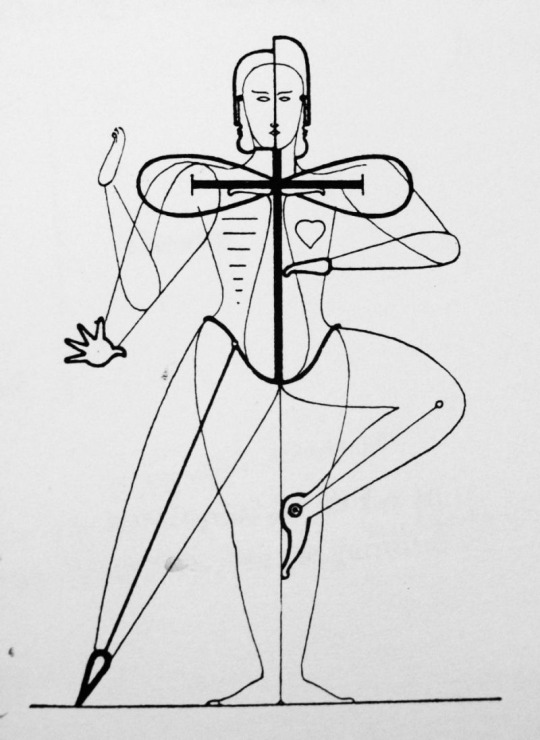
(project by Oscar Schlemmer)
So, what is the uber marrionette? Basically it's a slightly esoteric idea that somewhere between puppets and living actors exists a form which would be perfectly responsive to the director's artistic vision. Human actors were ego-driven, restricted by their bodies and minds which generally not malleable enough to be a good material, even going so far as to suggest that acting is not an artform at all, since it is driven by chance and not specific intentions.
In contrast to that, Craig explained the nature of puppets- perfectly controlled, humble, objects of worship. And also symbols of death. Which he thought of as perfection. So, in some way, a perfect actor is a ...dead actor. Or, not literally dead, but posseing the perfect stasis of death, one usually assosciated with inanimate objects.
OK, WTF?
As I mentioned those ideas are very cool theories but are rather hard to actualize in the real world, especially since Craig was sometimes vague about what he ACTUALLY wanted to see. He would complain about people misinterpreting his works and declaring that he wants to replace actors with literal machines, while also never specifying what he actually meant. So different artists tried to bring his ideas to life, mostly by "mechanising" living actors, or using some blend of life and artificiality. In practice it was mostly shit like putting actors in giant metal pots and making them communicate in mono syllables to restrict their natural expressions od self as much as possible

OK, BUT HOW DOES THAT RELATE TO PATHOLOGIC?
So my theory is, that by portraying the player character(s) as puppets in classic, and as actors and tying all of this to the idea of death, the makers of PAthologic are playing (pun intended) with the concept of the uber marionnette and maybe even proposing a solution to this impossible problem.
Let's start with classic, because it's pretty straight forward. The characters are dolls/puppets (I'll be using those words interchangibly because fundamentally they serve the same purpose). The theatre itself is specifically said to host puppet shows (which is in itself a nod to the long standing tradition of folk puppetry in Russia and other eastern european countries)

Which in hindsight, are a direct reference to the fact that the very story you are playing is nothing more than a game/puppet performance hosted by in-world The Powers That Be and at the very top by the makers of Pathologic. In that way it is a very straight forward (but ultimately incorrect) use of the uber marionette- the player character is a humble vessel through which an idea is manifested. It's a puppet made out of polygons and lines of code instead of wood or felt. Your role as a player in this performance is two fold- you are both the puppeteer (the one who moves the dolls) and the spectator (because you are being told the story, not the other way around). What you are not is the Director- that role, personified by Mark Immortel and later by the Executor and Tragedian is out of reach for you. So, as you can see it's definitely using puppets, but not necessarily uber marrionetes.
AND THEN WE HAVE PATHO 2
So, the theatre inspirations in Patho 2 are a lot less...subtle than in classic, one of them being literally namedropping my boi Artaud's concept of the Theatre of Cruelty.

But what I want to focus on in this case is the seeming dissapearence of the puppet metaphor from the first game. You are no longer compared to a puppeteer moving a vessel, but to an actor inhabiting a role. A role which is in a way highly restrictive, since there are only four endings, and only two choices that actually impact what happens in the end (what you do with the documents, and whether you take the fellow travellers deal or not) You are faced with the idea that you are replacable, so your personal ego is not valuable to the director in universe and the game creators out of the universe. And finally, to make it even more interesting, you are in-universe faces with the neverending cycle of life and death, through the system of deaths having consequences/being part of the game's continuous timeline instead of just out of universe reloading. I think you might already see where i am going with this.
I THINK THAT THOSE TRAITS MAKE ARTEMY'S PORTRAYAL SIMILAR TO THE CONCEPT OF THE UBER MARRIONETTE
So not the concept itself, but something that heavily resembles the ideal version of what it could have been. Now, does it theory make perfect sense? No, but I thought it was a cool though experiment to do nontheless. The idea of an uber marionnette is onfusing theatrologists to this day, and many people have claimed to having founf a way to realize it, but since Craig himself was unclear about it, we will never know how relevan those tries were. But I still think that the topic of video games and theatre concepts is a fascinating one (that will probably be the topic of my bachelor's thesis lol), and pathologic is a perfect examples of those two ideas working together. If you have any other ideas about it, please let me know, and if you're interested i can make more posts about the theatrological angle of patho!!
141 notes
·
View notes
Text
JayZoff: The Rising Star in Modern Music Production
In the ever-evolving world of music production, new talents emerge constantly, but few manage to leave a lasting impact. One such name that has been making waves recently is JayZoff. With a unique blend of innovative sound design, genre-defying compositions, and a keen ear for detail, JayZoff is quickly establishing himself as a force to be reckoned with in the industry.
This article delves into the journey of JayZoff, exploring his musical influences, production techniques, and the distinct qualities that set him apart from his peers. Whether you're a music enthusiast, an aspiring producer, or simply curious about the next big thing in music, this deep dive into JayZoff's artistry will provide valuable insights.
Who Is JayZoff?
JayZoff is a music producer and sound engineer known for his experimental approach to electronic and hip-hop music. While details about his personal life remain relatively private, his work speaks volumes. His productions often feature intricate layering, unconventional rhythms, and a seamless fusion of organic and synthetic elements.
Unlike many producers who stick to a single genre, JayZoff thrives in versatility. From ambient soundscapes to hard-hitting trap beats, his discography showcases an impressive range. This adaptability has earned him collaborations with underground artists as well as recognition from established names in the music scene.
The Musical Influences Behind JayZoff’s Sound
Every great artist draws inspiration from those who came before them, and JayZoff is no exception. His sound is a melting pot of various influences, including:
Electronic Pioneers: Artists like Aphex Twin and Flying Lotus have clearly left their mark on JayZoff’s experimental tendencies.
Hip-Hop Legends: The gritty textures of producers such as J Dilla and Madlib resonate in his rhythmic choices.
Film Scores: The atmospheric depth in his music suggests an appreciation for cinematic composers like Hans Zimmer.
By blending these diverse inspirations, JayZoff crafts a sound that feels both nostalgic and futuristic—a rare balance that keeps listeners engaged.
Production Techniques That Define JayZoff’s Work
What truly sets JayZoff apart is his meticulous approach to production. Here are some key techniques that define his work:
1. Layered Textures
Instead of relying on simple loops, JayZoff builds tracks with multiple sonic layers. Subtle background noises, modulated synths, and dynamic percussion create a rich listening experience.
2. Unconventional Drum Patterns
While many producers stick to standard 4/4 beats, JayZoff often experiments with off-kilter rhythms. His drum programming feels alive, with unexpected pauses and syncopated hits.
3. Hybrid Sound Design
He frequently blends acoustic elements (like live-recorded instruments) with digital synthesis, giving his tracks an organic yet futuristic feel.
4. Dynamic Mixing
Rather than over-compressing his tracks, JayZoff allows for natural dynamics, ensuring that each element has space to breathe.
Notable Tracks and Collaborations
Though still rising in prominence, JayZoff has already released several standout tracks and worked with talented artists. Some notable mentions include:
"Neon Dreams" – A hypnotic blend of synthwave and trap, showcasing his ability to merge genres effortlessly.
"Echo Chamber" (feat. LEXA) – A collaboration with an underground vocalist, highlighting his skill in crafting emotive, vocal-driven music.
"Fractal" – An instrumental piece that demonstrates his mastery of sound design and atmosphere.
These tracks serve as a testament to JayZoff’s growing influence and hint at even greater projects in the future.
The Future of JayZoff
As the music industry continues to shift toward independent and boundary-pushing artists, JayZoff is well-positioned to thrive. His willingness to experiment, combined with a strong technical foundation, makes him a standout figure in modern production.
Looking ahead, fans can expect:
More genre-defying releases
Potential collaborations with bigger names
Live performances or immersive audio-visual experiences
If his current trajectory is any indication, JayZoff is on the path to becoming a defining voice in contemporary music.
Why JayZoff Matters in Today’s Music Scene
In an era where many producers chase trends, JayZoff stands out by prioritizing originality. His work challenges listeners while remaining accessible—a rare feat in today’s oversaturated market.
For aspiring producers, JayZoff serves as an inspiration, proving that innovation and authenticity can carve out a unique space in the industry. For listeners, his music offers an escape into uncharted sonic territories.
Whether you’re just discovering JayZoff or have been following his journey, one thing is clear: he is an artist worth watching.
Final Thoughts
JayZoff represents the next wave of music production—where creativity meets technical excellence. His ability to push boundaries while maintaining emotional depth ensures that his music resonates on multiple levels.
As he continues to evolve, there’s no doubt that JayZoff will leave an indelible mark on the world of music. Keep an ear out—his best work may still be yet to come.

2 notes
·
View notes
Text
(the 2 most voted elements will continue onto round 2!)
More info about each element (and propaganda for the ones I like) under the cut. pleeeeeeeeease read some of them at least the one about francium
(disclaimer: these are based off short wikipedia reads and my crumbling high school chemistry knowledge. correct me if I'm wrong about anything.)
HYDROGEN: Hydrogen is the lightest element (consisting of only one proton and one electron). It is also the most abundant element in the universe, it's a gas (at room temperature) and it can explode. It's also quite representative of acids, having the (Arrhenius) definition of an acid straight up saying that it has to dissociate in water to form H+ ions. It's also quite an efficient fuel. Hydrogen is anywhere and Hydrogen is everywhere. If you like explosions, sour beverages, or acid in general, consider voting Hydrogen!
LITHIUM: Lithium, under standard conditions, is by far the least dense metal and the least dense solid element! You may primarily know him from your phone's Lithium-ion batteries. There are Lithium-based drugs used to treat mental illnesses. You can throw a block of lithium in water and it will make a really big explosion. The metal is soft and silvery. I'm running out of things to say about him. If you like batteries vote Lithium? (edit: just realised lithium is used for batteries, and batteries are connected to robotics and engineering. if you like robots and cool mechanical stuff vote lithium!)
SODIUM: You must know him from table salt. That's actually NaCl, his best known involvement. There are many more very important and very commonplace compounds that involve sodium, such as baking soda (NaHCO3) and sodium hydroxide (NaOH) (that's probably the most famous base?). It's also very important to the human body (you shouldn't eat more than 2300mg a day). If you've ever used table salt or baking soda while cooking, consider voting Sodium!
POTASSIUM: Their name was based on the word potash, which was based on an early and easy way of obtaining potassium, from putting ash in a pot, adding water, heating, and evaporating the solution. It's used in a lot of fertilisers because it's an essential plant nutrient. It's also involved in a ton of important compounds: KOH (a strong base), KNO3 (often used as salt bridges in electrochemical cells), K2CrO7 (an oxidising agent often used in organic synthesis), and K2CrO4 (I don't know what this one does). If you have ever eaten food from fertilisers consider voting Potassium!
RUBIDIUM: Rubidium compounds are sometimes used in fireworks to give them a purple color. They've also got a cool name, based on the latin rubidius, for deep red (the color of its emission spectrum). I'll be real, I don't really know much about them beyond that, but that is one cool name. Vote for Rubidium if you like cool names.
CAESIUM: Caesium is used in the definition for a second, meaning that an entire SI unit is based on it! A second can be defined as "the duration of 9,192,631,770 cycles of microwave light absorbed or emitted by the hyperfine transition of caesium-133 atoms in their ground state undisturbed by external fields". It was also discovered from mineral water. Did you know that they had to use 44000 liters of water to find her? If you've ever experienced time or had a conception of it in terms of units, consider voting Caesium!!!
FRANCIUM!!!: Caesium... TWO! It's sad that no one will probably read this far but this is my favourite element in this poll. This element is characterised by instability. Her longest half-life is 22 minutes. Her entire existence was conjoint with Caesium before they discovered that she was her own element. She has never been seen. They literally never confirmed what color she is. She was born in a wet cardboard box all alone. Through the hands of different scientists, she was going to be named after Russia, Virginia, or Moldavia at different points in time. At one point the name catium was proposed (for "cation", since she was believed to be the most electropositive cation), but was rejected because it sounded like a cat element. Which is so fucking sad. We could've had cat element but we ended up with France element. That's right she's also named after France. Just tragic fascinating existence overall. Also isn't it just insane that her half-life is only 22 minutes? Dude, you don't get it, the most of her that's ever existed in one place is a mere 300000 atoms. She's here and she's gone. What the hell.
The charm of Francium can be summarised by the wise words of my good friend Wolfgang Amadeus Mozart:

20 notes
·
View notes
Text
One of the reasons I love modular synthesis is that you're never completely limited by the features of your modules.
So I'm playing with a Christmas present, Behringer's clone of the old Roland Model 182 sequencer. It's a very simple sequencer, maybe even more limited than some Baby8s I've seen — at heart it just loops through its eight steps and outputs two channels of CV following their pot settings. It's got a built-in clock, and you can manually adjust the pulse width of that corresponding gate output, but you can't, say, mute specific steps or constrain the output to musical scales.
Except by adding more modules.
I'm using the first channel as the pitch CV, and running it through my Dumbest Possible Quantizer I posted about last night; this lets me tune each step of the pitch by (rough) chromatic notes, instead of just a continuous pitch gradient. I'm then using the second channel as a gate channel — turning the muted steps all the way down and the playing steps up — and running that CV into my Lola module's binary input to be ANDed with the gate, where the output triggers the envelope generator. So the envelope — which is controlling both the VCA and the filter cutoff — only triggers on those gates where channel 2 is turned up enough to register.
Admittedly, by jumping through these hoops, I'm basically just coercing three modules into doing the same job I could easily do with a BeatStep. But it's the principle of the thing, isn't it?
2 notes
·
View notes
Text
Chapter 196 Trivia (Part 1)
Scientist Suika is here to save the day!

A callback to Senku in chapter 14! Except this time, Suika doesn't have the core principles of science in mind— she has Senku instead.
I wonder if Senku's ever explained what that equation means to her…


I thought Suika's melon was replaced with something else because of the ridges present, but it looks like it's still the same melon we know and love.
Also, the red ribbon in the village rope is visible! Remember this for later.

A pair of toucans have made a nest next to Suika's little hut on top of the tower. I'm convinced Suika is actually a disney princess with her ability to attract and tame animals (Chalk, Sagara, the monkeys from earlier…)

In case you don't remember Ukyo's kindergarten school teacher moment, it's from back in chapter 99.
Kinro and Magma attended the science academy classes as well!
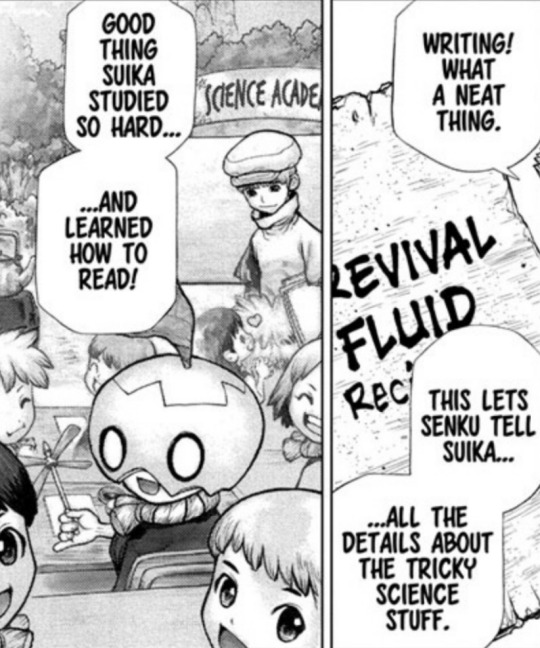


The 3 methods Suika mentions: firstly, the Ostwald process. This is the one Senku uses on Treasure Island and similar to the Haber-Bosch process Xeno used. This is the one that required platinum.
I assumed this was the one she attempted first (though she has no platinum) except…

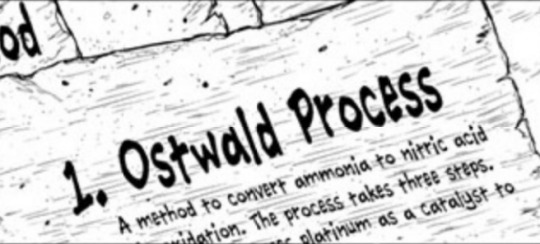
…The process doesn't actually use sulfurina/sulfuric acid. Instead, I believe the process she tries is single displacement synthesis which uses sulfuric acid and a nitrate salt like potassium or sodium nitrate.


The second method is known as the Birkeland–Eyde process, which involves heating up the air using electricity, forming nitric oxide. This is then dissolved into water, forming nitric acid.

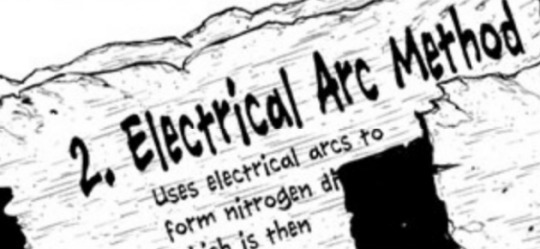
The final method is the man-made version of what was happening in the Cave of Miracles, where feces is left under certain conditions so that it can decompose into nitric acid. The right humidity is also necessary, which is why Suika is watering the mounds!

Suika's science setup! Not sure where that wheel is rolling from, but you can see Suika has all the pots and jars ready for measuring, along with a kiln and a set of scales.
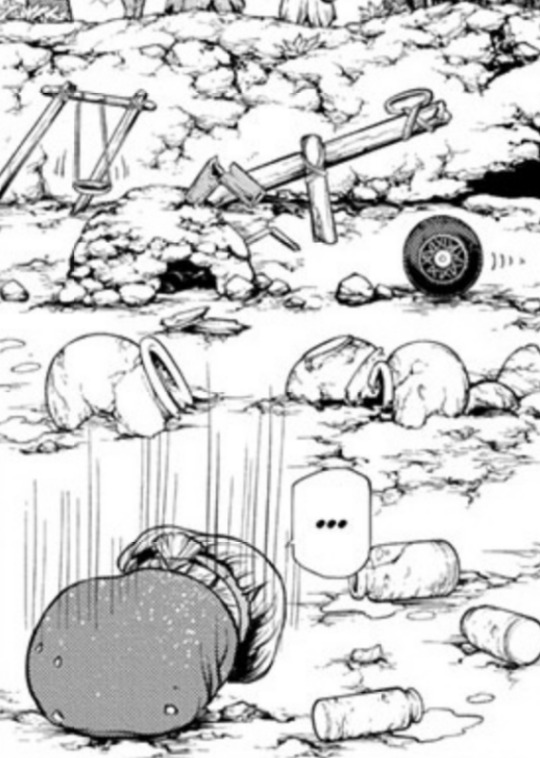

Even without her melon, Suika still rolls around. 🍈💨

A crappy fact: capybaras actually poop pellets, similar to those of rabbits, but slightly more oblong.
I won't include a real-life image of it.

The birds Suika finds are most likely roseate spoonbills, a large wading bird whose habitat includes the mouth of the Amazon river. The one perched on Suika's boat is probably a juvenile as it lacks the red band normally found on its wing.



The Sengoku period is a time when Japan was in almost constant civil war from 1467-1615. As such, they needed gunpowder for the matchlock guns they were using, and thus used this method to create the nitric acid necessary.

Suika's writing with the ashes of a burnt stick onto a leaf, so I assume any other writing tools they had are long gone. They must have had some on them at some point though because both Senku and Chelsea were writing small details, and I don't think a burnt stick can do that.
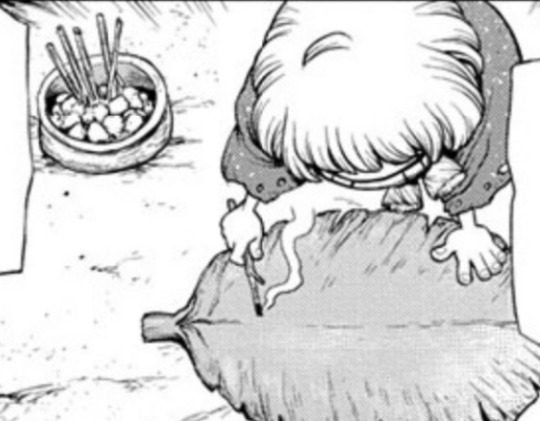
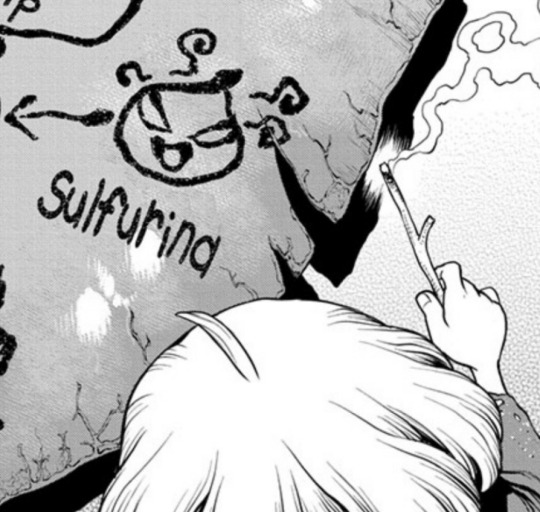

Suika found a mangrove, a Brazilian grapetree/jabuticaba and a huge mollusc with its siphon sticking out. Nice job Suika!




(Next part)
16 notes
·
View notes
Text
[Vayne in Atelier Resleriana's 3D Model Character Showcase Review Part 3] 25 February - 13 March 2024
This is first time Vayne going Synthesis to making Tranquil Salve or Thunder Armor




I can explain why he's looks like Sora from Kingdom Heart during Synthesis.
His Al-Revis collar uniform still error!









Woooow…!

He's so cool~
but it still problemly his front hair, Haaaa-ha-ha-ha-ha-ha…! I'am notice, i tried my best to caught screenshots so bad...
Wooooo….



A Lights became bright white than previous bright yellow that's mean it's much more highest traits. every i get SSR V/VI well. It's because wanna on Event Mission: Synthesize! Synthe-prize! Campaign i don't have time to make lot battle-items before event over, i will but the next event be appear next day. However i'am still didn't get SSR V/V while SR V/V had only got 2 for Lightning Equipments: Thunder Armor and King of Thunder Ring.





Why he's looks like Riku from Kingdom Heart again?! during Synthesis was finish.




I don't know when Vayne and Meruru seen pot inside, that's mean it got highest traits lucky. No maaan…

Vayne's poses had similar Logy's poses during Synthesis Also Raze and other male characters has too in menu character & party but not all.



Oh yes i have something important about... Vayne can use alchemy- wait what???
It's only know found posted from twitter by kuuki099: [Part 1] and [Part 2]
"For now, since Vayne is one of the items in Chapter 4, it doesn't seem like alchemy is impossible to use."
"I've been thinking about the difference between the "mana" in the Mana Khemia world, but Vayne said, "It's different from the mana in my world"... It is unclear whether this is saying that "mana as energy" is different, or whether they are "comparing mana as a spirit with materialized mana."
I did use to translated if important post has gone forever on next year. I feel confused about Vayne can use alchemy…?
#atelier#atelier games#atelier series#atelier resleriana#mana khemia#screenshot#vayne aurelius#logix ficsario#corneria#shallistera argo#escha malier#linca#esty dee#merurulince rede arls#valeria#razeluxe meitzen#cordelia von feuerbach#tao mongarten#oskar behlmer
4 notes
·
View notes
Text
9 years into taking the exact same ADHD meds (that also treats my POTS and chronic fatigue and most of my allergy symptoms as a fringe benefit) every single day, and they're still making me take drug tests to prove I'm taking the exact prescribed amount and absolutely not one iota more or less in case I'm like selling it or doing meth too I guess? Tests which I have never once failed in nine years.
And refusing to trust me with the normal procedures of getting them filled and instead makes me do insane red tape hoops and jumps coordinating contact and details between multiple people that consumes most of the 12 days prior to actually receiving my monthly supply, in order to receive that monthly supply, so I'm dealing with that for about half of every month and every single month the doctor AND pharmacy get their timing wrong and I run out and get withdrawal for at least 2 or 3 days every single month.
But god I mean people with ADHD are so unreliable right??? Their shitty brains cause such ups and downs and they're so disorganized and never get things done due to being lazy! What a burden it must be for these people to have to put me through bullshit work that takes a huge amount of focus and attention to details and synthesis of multiple moving parts for half of the days of my entire month and then also put me through monthly medication withdrawal. What saints they are to do that to me
I mean thank god it's not like, lifesaving medication. It only ruins my entire life to be without it, and the recurrent withdrawal hurts me physically and causes problems with at least three separate conditions that interfere with my daily life. it doesn't ACTUALLY kill me
#idk how to tag this urgh#doctor problems -/ ??????#cw beimg treated like a drug lord or addicted to my daily medication#ask me to tag
4 notes
·
View notes
Text
History & Heritage
Threads of Time: Unraveling Pakistan’s Rich History and Heritage
Pakistan’s identity, though officially carved in 1947, is rooted in a cultural and historical lineage that stretches back thousands of years. The land that forms present-day Pakistan has been a cradle of civilizations, a crossroads of empires, and a repository of traditions that continue to shape its collective soul. From ancient cities buried in the sands of Sindh to Sufi melodies echoing through Punjab, Pakistan's heritage is both timeless and alive.

The Dawn of Civilization: Indus Valley
The story begins over 4,500 years ago with the Indus Valley Civilization—one of the world’s oldest urban cultures. Cities like Mohenjo-Daro and Harappa were marvels of ancient urban planning. With grid-like city layouts, complex drainage systems, and standardized weights and measures, the civilization showed a high degree of social organization and technological advancement.
Artifacts, from beautifully carved seals to pottery and tools, reveal a society rich in art and trade. Unlike other ancient societies, the Indus Valley people appear to have lived relatively peacefully, without evidence of large-scale warfare or a ruling elite, making them unique among early civilizations.
Cultural Convergence: Invasions and Empires
After the decline of the Indus Valley, the region became a melting pot for various cultures and empires. The Aryans introduced the early Vedic culture, which laid the foundation for much of South Asia’s religious and philosophical thought.
Later came the Achaemenid Persians and Alexander the Great, who brought Hellenistic influence to the region. The city of Taxila, now in Punjab, emerged as a major hub of learning where Buddhist, Greek, and Hindu philosophies intermingled. The Gandhara civilization, with its iconic Greco-Buddhist art, stands as a symbol of cultural synthesis.
Over centuries, empires such as the Mauryas, Kushans, Guptas, and White Huns left their mark. Their legacies are seen in sculptures, coins, monasteries, and ancient roads still visible in parts of Pakistan today.
The Coming of Islam
Islam began shaping the cultural landscape in the 8th century with the arrival of Arab general Muhammad bin Qasim, who brought Islam to Sindh. Over time, the region became an integral part of various Islamic empires, including the Delhi Sultanate and the Mughal Empire.
The Mughals, in particular, contributed richly to the architectural and cultural heritage of PAKISTAN, and the Shalimar Gardens are living testaments to Mughal grandeur. Persian art and calligraphy, as well as music and poetry, flourished under their rule.
Islam in South Asia also saw the rise of Sufism, a mystical form of Islam that resonated deeply with local traditions. Sufi saints like Lal Shahbaz Qalandar, Shah Abdul Latif Bhittai, and Bulleh Shah became cultural icons, blending spiritual teachings with folk expression.
Colonial Rule and National Awakening
The British colonization of the Indian subcontinent in the 19th century brought sweeping changes—railroads, new administrative systems, and Western-style education. While this led to modernization in some areas, it also disrupted traditional ways of life and subordinated the region’s rich cultural identity.
However, the colonial period also sparked movements of resistance and self-discovery. Thinkers like Sir Syed Ahmed Khan advocated for modern Muslim education, while Allama Iqbal called for cultural and spiritual revival. These movements laid the groundwork for the creation of Pakistan in 1947.
The Partition of India, while granting independence, came at a devastating cost—millions displaced and hundreds of thousands killed. Yet, it also marked the beginning of a new chapter in reclaiming and reshaping a national identity.
Post-Independence Heritage Revival
Since independence, Pakistan has worked to preserve its ancient and recent past. Museums, archaeological departments, and cultural institutions have played a key role. The Lahore Museum, Taxila Museum, and Lok Virsa Museum in Islamabad house incredible collections that reflect Pakistan’s diverse heritage.
At the same time, there has been a growing awareness among Pakistanis to protect historical landmarks, many of which are threatened by urban expansion, neglect, or environmental decay. Projects like the Walled City of Lahore restoration show that when public and private sectors collaborate, heritage preservation becomes possible and sustainable.
Living Heritage: Languages, Art, and Tradition
Cultural heritage in Pakistan is not confined to stone structures and dusty manuscripts. It lives on in the languages, crafts, and customs passed down through generations. Over 70 languages are spoken across Pakistan—from Punjabi, Sindhi, Pashto, and Balochi to lesser-known tongues like Burushaski and Wakhi.
Each region has its distinct music, dance, and craft traditions. The Ajrak of Sindh, Phulkari of Punjab, Kalash woodwork, and truck art are all expressions of local identity and creativity.
Music, too, remains a powerful thread that ties communities to their past. Whether it’s the hypnotic rhythm of the dhol, the soulful renditions of qawwals, or the evolving world of fusion music, Pakistan’s sonic heritage is dynamic and deeply rooted.
Modern Technology, New Possibilities
In recent years, technology has opened new doors for heritage preservation. Digital archives, 3D mapping of archaeological sites, and virtual museum tours are helping younger generations connect with the past in innovative ways.
Social media campaigns have also brought attention to endangered sites and traditions. Young content creators, researchers, and historians are using platforms like YouTube, Instagram, and TikTok to share snippets of history, reviving forgotten narratives and promoting tourism.
Conclusion: Embracing the Many Layers
To understand Pakistan’s heritage is to understand the layers of human experience—peaceful settlements, cultural convergences, spiritual awakenings, and identity struggles. It’s a complex but beautiful mosaic, still being pieced together today.
As the country navigates modern challenges, holding on to its historical and cultural legacy becomes ever more important. For in knowing where we come from, we better understand where we’re going.
ABOUT ME:https://www.tumblr.com/
FAQs
Q1: What are some of the most important historical sites in Pakistan? A: Some key historical sites include Mohenjo-Daro and Harappa (Indus Valley Civilization), Taxila (Buddhist and Hellenistic heritage), Lahore Fort and Badshahi Mosque (Mughal architecture), Rohtas Fort (military history), and Makli Necropolis in Sindh, one of the world’s largest burial grounds.
Q2: How can the youth of Pakistan contribute to preserving its heritage? A: Young people can participate in heritage walks, volunteer for conservation projects, document oral histories from elders, or create digital content about local history. Promoting local languages, crafts, and stories also helps keep heritage alive.
0 notes
Text
Acne skin care solution
Acne skin wants to look good all over the face, not break out and look even and delicate skin
You can't even tell you're a 10-year pox
The complete acne skin care idea must be: acne + repair + control inflammation
In addition to acne itself, repair and prevention/dilution of the work must be done
Many acne sisters acne is acne, the face is rotten, but also black three or four degrees
All of this could have been avoided
The current mainstream view basically recognizes:
There are two reasons for repeated breakouts in the final analysis: ① oil blockage and ② inflammation levels
What you mainly solve with acid, VA, and oil control products is ①
② is more complicated than ①, in addition to oral application of anti-inflammatory yao (not skin care products
What's more, you need to learn your own systemic conditioning to control the level of inflammation throughout your body
People always ask: How can I stop getting acne? Or why did I break out again? In fact, this problem is superfluous, because diet, work and rest, mood, you always have a little problem. Especially in adolescence does not have acne, adult, after work quack long
Most of them do not like to eat vegetables, stay up late and eat late night snacks, and barbecue hot pot three times a week
六、How can transamine acid be used more effectively
The usage cycle I tested was like this:
Red rose skin: Every two weeks, morning and night once a day
Postoperative anti-black: After non-wound surgery, such as photon can be used that night, and it can be applied for a week, if it is laser or picosecond freckle, it can also be applied for a longer time (especially worry about anti-black one week before the operation should also be applied)
Full blush Black Improvement/Sensitive Red skin whitening: more than one month
It is mainly to inhibit the synthesis of neochrome, so it will be patient for a period of time before the overall white, but the skin will look much brighter after it is not so red
Fade melasma: Lock for life
Melasma can not be cured, not too obvious after it is still recommended to regularly apply a bright acid, to maintain a healthy skin tone
The effect of the acid is not as fast as we think, we really need to stick to it, many people are using three or four bottles to feel the skin is getting better, and the more stable white is used, it is difficult to anti-black, which is the benefit of it compared with other ingredients (more suitable for slow temperament).
However, Chuanming acid with asiatica licorice or siryotel to red pimple mark is still quite fast, this basic within a week to have an effect
Your goal is different, the use of transom acid is not the same, the market of Transom acid essence is generally 3%, 5% and less than 3% (Transom acid as an auxiliary ingredient) these three categories
Just want to stabilize the white, choose 3% transom acid with other ingredients can be
For example, the classic 3% transferuric acid ➕5% nicotinamide (there are many of these, you can search it, there are also 2% nicotinamide)
Perea is 3% tranmitic acid ➕335 (autophagy) and Shiseido is tranmitic acid ➕4msk
Postoperative anti-anti-black I recommend direct use of 5% concentration
Gold microneedles and stripping dot matrix are more recommended to use the initial Yin blue healing, which has the added effect of promoting barrier recovery, and the skin will return to a delicate and stable state faster when the skin is not red and black
Stubborn reddish-black spots on the chin, cheeks and forehead, as well as melasma
What works best for me: apply thick, apply more, preferably wet three times a week
This wet compress is filled with wet compress cotton essence, stick on the face for half a minute to a minute is enough, do not apply to dry, peel off more essence and then squeeze back to apply evenly
This method can help my suddenly red and black chin quickly return to white in one to two weeks, and then with 10 minutes of yellow light every day, the whiteness is easy
However, if only a small amount of 3% concentration of tranming acid essence is applied, the effect is not so obvious, and it is more reactive and even chicken, which is easy to make people have no power to stick to
0 notes
Text
Discover innovative storage solutions and beautiful finishes that will inspire you to whip up delicious meals every day
When it comes to designing the perfect kitchen, more than just fashion is at stake, functionality being the key for Gold Coast homeowners who love sun-kissed living combined with a desire for something contemporary. kitchen makeovers Gold Coast come in a whole new meaning for these homeowners. Embracing cutting-edge storage solutions and gorgeous finishes can turn your mundane cooking space into something magical that sparks creativity and makes the task of meal preparation fun and enjoyable.
Innovative Storage Solutions
One of the biggest challenges in kitchen design is maximizing storage without sacrificing style. Enter innovative storage solutions that cater to the demands of modern kitchens. When contemplating kitchens designs Gold Coast QLD style, think beyond traditional cabinets and drawers. Incorporating deep pull-out drawers can provide easy access to bulky pots and pans, while vertical dividers for baking sheets and cutting boards keeps everything organized and within reach.
For a modern touch, go for corner cabinets with lazy Susans or pull-out shelves, which use every inch available. The best cabinet makers Gold Coast can design these styles to match the aesthetic of your preference. And don't forget about integration power; it can have a hidden appliance like a dishwasher or microwave behind a cabinet door for a streamlined and clutter-free look.
Beautiful Finishes
Once you've addressed storage, the next step is to select beautiful finishes that reflect your personal style. The Gold Coast is known for its vibrant lifestyle, and this can be mirrored in your kitchen's design. For those drawn to a clean, minimalist approach, consider high-gloss white cabinetry paired with sleek quartz countertops. This combination offers a timeless feel while keeping the kitchen bright and airy.
On the other hand, if you want warmth and character, hardwood finishes and textured stone surfaces can add depth and sophistication. Available finishes can range from rustic oak to elegant walnut, each with its unique charm to enhance the kitchen space.
Another factor to consider is the effect of color on your kitchen makeover. Bold accent colors can be introduced using backsplash tiles or accessories, creating focal points that draw the eye. Soft pastels or muted tones can evoke calm and serenity, making your kitchen an inviting space to unwind after a busy day.
Function Meets Aesthetics
The marriage of functionality and aesthetics is always critical in any kitchen makeover. Every design element has to be contributing to the usability of the kitchen. For example, adding open shelving allows for decorative displays of dishes or cookbooks while allowing easy access to frequently used items.
Custom kitchen cabinets Gold Coast - Tailored solutions lend themselves readily to custom options. You may make use of floating shelves to store your best kitchenware-a stylish and practical solution which is especially effective in less spacious areas. A thoughtful layout would allow you to create 'work zones' like cooking, prep, and clean-up areas by minimizing movement and maximizing productivity in the very heart of your home.
The perfect synthesis
Whether embarking on a complete kitchen renovation or simply looking to refresh your existing space, innovative storage solutions and beautiful finishes are the keys to a successful kitchen makeover. The Gold Coast boasts a wealth of talented kitchen cabinet makers Gold Coast who can turn your vision into reality, ensuring your kitchen reflects both your personality and your culinary aspirations.
It has inspiration around every corner and takes one to local showrooms, talking to design experts, and immersing him/her in the latest trends to understand what he/she likes. There's the perfect synthesis of functionality and style that inspires cooking a tasty meal every day.
Your kitchen should be much more than a space for the mere preparation of meals; it is an environment that should spur creativity and bring happiness into cooking. Explore innovative storage solutions and beautiful finishes to turn your kitchen into a culinary haven. So, what are you waiting for? The time to renew your kitchen makeover on the Gold Coast is now. Your dream kitchen is just a design away.
#kitchen cabinets#kitchen design#commercial office fit out companies#bathroom cabinets gold coast#kitchen cupboards#bathroom renovations gold coast qld#commercial office fit out#custom cabinets#bathroom accessories gold coast#kitchen designers gold coast
0 notes
Text
New Non-Toxic Molecules for Alzheimer’s Treatment Developed
Scientists at the Agharkar Research Institute in Pune announced a breakthrough in Alzheimer’s disease treatment. They created new non-toxic molecules that could potentially change how we approach neurodegenerative diseases. This development comes at a critical time, as Alzheimer’s affects millions globally.
About Alzheimer’s Disease
Alzheimer’s disease is a progressive neurodegenerative disorder. It is the leading cause of dementia, affecting 60 to 70 percent of the 55 million people living with dementia worldwide. The disease is characterized by memory loss, cognitive decline, and changes in behaviour. The condition arises from an imbalance of hormones and neurotransmitters in the brain. A key neurotransmitter involved in memory and learning is acetylcholine. Its reduction is linked to the symptoms of Alzheimer’s.
Current Treatment Limitations
Existing treatments for Alzheimer’s primarily focus on symptom management. They often have side effects and do not address the underlying causes. There is an urgent need for new therapies that are both effective and safe.
New Molecules Developed
Researchers at the Agharkar Research Institute focused on creating novel molecules. They employed a rapid one-pot, three-component reaction. This method allows for the efficient synthesis of new compounds with high yields. The newly developed molecules are non-toxic. This makes them a promising option for long-term use in Alzheimer’s treatment.
Targeting Cholinesterase Enzymes
The research team found that these new molecules effectively target cholinesterase enzymes. Cholinesterase is responsible for breaking down acetylcholine in the brain. By inhibiting this enzyme, the new molecules increase acetylcholine levels. Higher acetylcholine availability can enhance memory and learning capabilities. This mechanism could lead to improved cognitive function in Alzheimer’s patients.
Research Methodology
The development process involved a combination of synthetic chemistry, computational studies, and in vitro experiments. Synthetic chemistry was used to create the new molecules. Computational studies helped predict their effectiveness and safety. In vitro studies tested the molecules in controlled environments to assess their impact on cholinesterase activity. This multi-faceted approach ensures that the molecules are not only effective but also safe for potential use in clinical settings.
Implications for Neurodegenerative Disease Treatment
The findings from this research could have broader implications. They may pave the way for new treatments for other neurodegenerative diseases. Conditions like Parkinson’s and Huntington’s could benefit from similar approaches. The focus on non-toxic molecules is particularly. It opens up new avenues for long-term treatment options that are less likely to cause harmful side effects.
Future Directions
Further research is essential to understand the full potential of these new molecules. Clinical trials will be necessary to evaluate their effectiveness in human subjects. Scientists will also explore the mechanisms behind the molecules’ action. About how these compounds interact with the brain will be crucial for future developments. The Agharkar Research Institute’s work represents an important step forward in Alzheimer’s research. It marks the importance of innovative approaches in tackling complex diseases
website: popularscientist.com

0 notes
Text
Contemporary Rug Design: A Melting Pot of Art, Functionality, and Modern Aesthetics
These rugs have become more than just functional; they are significant elements in interior design-capable of making a room different with their bold patterns, innovative textures, and vibrant colors. contemporary rug design The world of modern rugs fuses traditional craftsmanship with modern creativity in pieces both artistic and practical. This article explores what makes contemporary rug design tick, the key characteristics, and its role within the interior spaces of today.
1. Defining Contemporary Rug Design
Whereas traditional rugs adopt a conventional motif or pattern, modern rugs present abstract or very minimalist ideas. While traditional rugs conventionally sport floral or geometrical patterns from cultural heritage, contemporary rugs will find their inspirations from current artistic trends, nature, architecture, and even technology. Everything from bold, graphic patterns to subtle, textured weaves is possible in a wide range of options to fit different tastes and interior styles.
This freedom in design can make the contemporary rug either the central element in the room or a subdued addition to the general decoration of the room. Often, they embed both traditional and non-traditional materials, including wool, silk, synthetic fibers, and even recycled material, reflecting attention to quality and sustainability alike.
2. The Use of Color in Contemporary Rugs
Color becomes a very important aspect in modern rug design and sometimes may lead or be the point of attraction that dictates the style of the room. Modern rugs are designed to be bold in their use of color, either with contrasting juxtaposition or harmonious melting. The coloring can range from full-on monochromatic schemes to vibrant, multi-colored compositions, giving designers leeway to create pieces that relate directly to the mood and purpose of the space.
3. Uncovering Pattern and Texture
As much as modern rug design is about pattern, it is about texture. Designers are often experimenting with various techniques of weaving, pile heights, and materials to achieve unique tactile qualities in their rugs. The texture of a contemporary rug can add depth and dimension to a room, layering the feeling of the room and adding interest.
Modern rugs take their cue from abstract art, with asymmetry, irregular shapes, and unorthodox forms taking center stage. Their patterns can be as soft and subtle or as bold and catching, depending on the impression one wants to create. It is this freedom of experimenting with pattern and texture that allows the modern rug to break free from traditional rug conventions into new, innovative options for today's interior.
4. Where Tradition Meets Modernity
With the modern designs of rugs today, there is often an incorporation of traditional craftsmanship. Most of the rugs today are either hand-knotted or hand-tufted, methods traceable to the earliest centuries. Such a marriage of old and new produces rugs that are modern-looking yet durable and of the quality of handmade traditional pieces.
For this reason, artisans and designers can reinterpret classic patterns and techniques within a modern framework and rework the rugs in a style that is fitting to their heritage but appealing to the modern taste. It is just this synthesis of the traditional with the innovative that makes contemporary rugs so unique and sought after in today's market.
5. The Impact of Technology
Technology has had a great influence on contemporary rug design, offering the possibility to experiment with new materials, techniques, and digital design. Computer-aided designs allow the designer to work out an accurate pattern and even make changes in the design. The newer dyeing techniques are also an advancement in the field, increasing the gamut of colors available for use. Other sustainable practices, such as using recycled materials or eco-friendly dyes, have been increasingly prevalent with the growing demand for environmental consciousness regarding design.
6. The Versatility of Contemporary Rugs
Probably one of the strongest points concerning the use of modern rugs is versatility. Starting with places where people reside, such as living rooms and bedrooms, to commercially used areas like offices and hotels, modern rugs can be utilized in any area desired. Again, modern rugs come in a number of sizes, shapes, and styles that can fit any room and decor.
Be it a vibrant large rug to make a statement, or subtle and textured to add a touch of elegance, there are endless ways contemporary rugs can add beauty and functionality to a space.
Conclusion
Contemporary rug design celebrates modern aesthetics, where creativity and functionality go hand in hand. A contemporary rug, blending traditional craftsmanship with innovative techniques and materials, offers a fresh and versatile approach to interior design. Whether adding color, texture, or that singular art element to your space, these contemporary rugs have endless options that may turn any room into space worth spending time in-essentially, a part of modern living.
0 notes